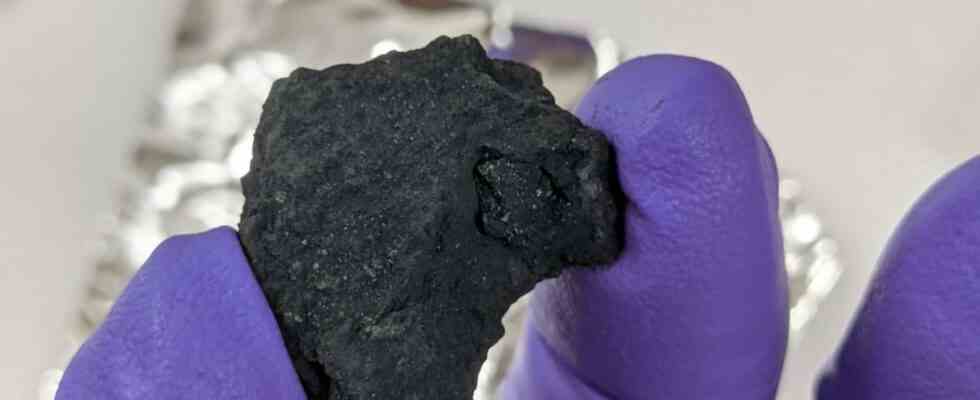At 9:54 p.m. on February 28, 2021, a fireball streaked across the English sky for about eight seconds. A few thousand people saw and heard the cosmic spectacle and its sonic boom.
Now a research team led by Ashley King from the Natural History Museum in London is presenting in the journal “Science AdvancesResults of analyzes of fragments of the meteorite subsequently found near Winchcombe, a small town in south-west England. Accordingly, it not only contained water, but also amino acids. So he carried two of the substances that are essential for life on earth.
The meteorite must have weighed about 30 kilograms and had an estimated diameter of 30 centimeters before it hit the earth’s atmosphere. Barely half a kilogram hit the ground, the largest chunk of which shattered on a road near Winchcombe. Twelve hours after the impact, meteorite hunters found 319.5 grams of splinters and dust from the cosmic bolide and packed them in plastic bags.
“It is a stroke of luck that the Winchcombe meteorite came into the hands of science so quickly,” explains Dieter Heinlein. It usually takes much longer, says the meteorite specialist at the Institute for Planetary Research at the German Aerospace Center (DLR) in Berlin-Adlershof. The fragments often disappear under dense vegetation, sink into bodies of water and are only discovered weeks later or never at all. The longer a meteorite is out in the open, the more it becomes contaminated by terrestrial material, such as animals or humans, who transfer amino acids and genetic material to the find when they touch it.
A “fresh” meteorite, such as that from Winchcombe, allows an unclouded view of the early days of our solar system, when the sun and the gas planets Jupiter and Saturn had just formed. In the outer, cold regions, “chunks and small celestial bodies formed, in which, in addition to solid water ice, there was also carbon and thus the basic element of life,” says DLR asteroid specialist Alan Harris from the Berlin Institute for Planetary Research.
Not only water, but also other vital molecules
Deflected by Jupiter’s gravity, these asteroids may have entered the inner parts of the planetary system and helped form the Earth there. They could also have supplied the water to our planet. Some of these asteroids, which contain carbon and water ice, have survived to this day in the outer area of the asteroid belt.
Some of this cosmic debris is flung near Earth’s orbit when it collides with other pieces of rock. According to King and Daly, the Winchcombe meteorite broke off from its parent body and made its way around the earth only a few millennia ago. “When you heat these meteorites, they exude quite a lot of water,” explains Alan Harris. They can therefore definitely be considered as suppliers of the primordial water on earth. Both the analysis of the Winchombe meteorite and other extraterrestrial chunks revealed a lot of water with a hydrogen isotope signature that differs little from that of terrestrial water.
Amino acids were also found in the debris of the Winchcombe meteorite, the basic building blocks for proteins, without which life on earth cannot do. These could also have come to earth with meteorites. In any case, such finds are not uncommon. The samples brought back by a Japanese probe from the asteroid Ryugu also contained many amino acids. “Now we are eagerly awaiting the samples from the asteroid Bennu, those from the US Osiris Rex Mission to be brought to Earth on September 24, 2023,” says Alan Harris.

